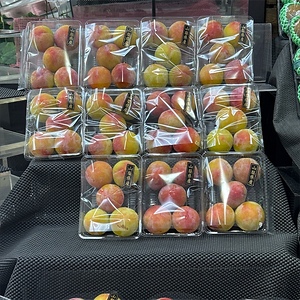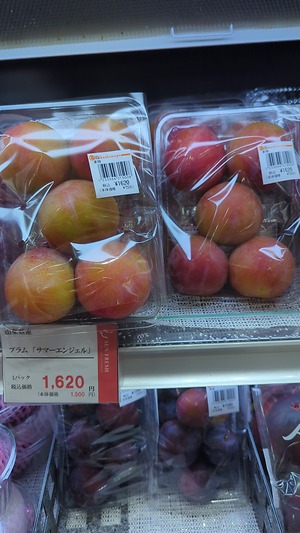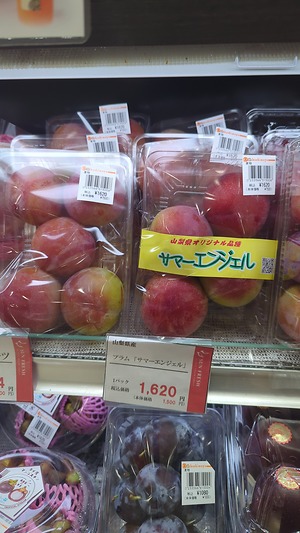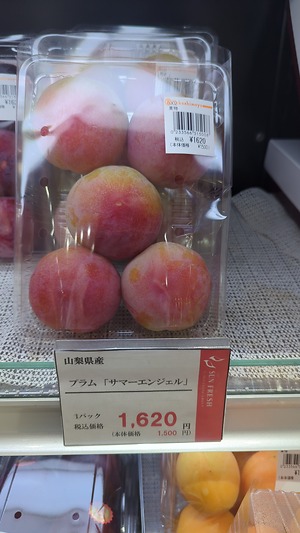


Japanese Summer Angel Plums
Estimated Inventory, lb : 0
Description/Taste
Summer Angel plums are a medium to large varietal, averaging 120 to 160 grams in weight, and have a round to oblate shape with a blunt, curved nature and a prominent crease down one side of the fruit. The skin is thin, smooth, and taut, displaying vibrant red-purple hues. The surface is also covered in a powdery blue-grey bloom. This bloom is natural and edible and is developed by the fruit to help keep moisture in the flesh. In Japanese markets, the more bloom the fruits showcase, the fresher the fruit is considered to be. Underneath the skin, the golden yellow flesh is tinged with red just beneath the surface and has an aqueous, tender, crisp, and succulent consistency. The flesh is low in fiber and envelops a central light brown seed that is tightly adhered. Summer Angel plums do not release a strong fragrance when ripe and are determined ripe by their weight. They should feel heavy for their size and will have noticeable rings surrounding the base of the fruit. The higher the number of rings, the riper the flesh. Summer Angel plums are known for their sugar content, ranging from 15 to 17 degrees Brix, creating a sweet and fruity taste. The skin has a notably tart and sour taste, balancing the sweetness of the flesh when eaten together.
Seasons/Availability
Summer Angel plums are available in mid-summer through late summer, a peak season from July through August.
Current Facts
Summer Angel plums, botanically a part of the Prunus genus, is a modern Japanese variety belonging to the Rosaceae family. The pigmented fruits were developed in the Yamanashi Prefecture in the late 20th century and were commercially released in the 21st century. Since their arrival as a fresh market variety, Summer Angel plums have become popular in Japan during the summer months. Summer Angel plums are favored for their easy-to-eat nature. The plums taste sweet and sour and are versatile, utilized in fresh and cooked preparations. Currently, the variety is localized to commercial markets in Japan, but as it expands in popularity, the plums may spread to other Asian markets.
Nutritional Value
Summer Angel plums, like other commercial plums, are a source of calcium to support bones and teeth, vitamin C to strengthen the immune system, potassium to balance fluid levels within the body, and magnesium to control nerve functions. The fruits also provide vitamin A to maintain healthy organ functioning, phosphorus to repair tissues, fiber to regulate the digestive tract, iron to develop the protein hemoglobin for oxygen transport through the bloodstream, and other nutrients, including zinc, copper, folate, vitamin K, and manganese. The pigmented skin indicates the presence of anthocyanins, natural compounds that contain antioxidant properties to reduce inflammation and protect the cells against the damage caused by free radicals.
Applications
Summer Angel plums have a sweet, tart, and tangy taste suited for fresh and cooked preparations. The variety is typically consumed out of hand and is appreciated for its tender, juicy, and refreshing nature. Summer Angel plums can be eaten with or without the skin, depending on preference. The skin has a sour taste, so some consumers may choose to peel it before eating. Others enjoy the sour flavor to contrast the sugary sweetness of the flesh. Summer Angel plums can be sliced and served in salads, mixed into fruit medleys, or displayed on appetizer platters with fresh cheeses. The fruits can also be topped with herbs, used as a variation of caprese with mozzarella cheese, radishes, and almond slices, or blended into shakes and smoothies. In addition to fresh preparations, Summer Angel plums are simmered into jams, jellies, and compotes or cooked into syrups for use in beverages and desserts. The syrup is often mixed with water to make a refreshing beverage in Japan. Summer Angel plums are also blended and frozen into sorbet, ice cream, and popsicles. Beyond cold items, the plums are used as flavoring in cakes, tarts, and parfaits. They are also juiced and heated into plum tea. Summer Angel plums pair well with herbs such as thyme, sage, perilla, and mint, ginger, vanilla, spices including nutmeg, ginger, and cardamom, and nuts such as almonds, walnuts, and pecans. Whole, unwashed Summer Angel plums will keep for 2 to 4 weeks when stored in the refrigerator.
Ethnic/Cultural Info
Summer Angel plums were named for their arrival to markets during the summer season. The plum variety is favored among consumers for its refreshing, juicy, sweet, and sour taste and is often chilled before consumption to provide a thirst-quenching reprieve on hot summer days. Summer Angel plums are also usually cooked into syrups for drizzling over shaved ice. In Japan, shaved ice is known as kakigori and is a cherished, traditional dessert that has been enjoyed in the summer for centuries. The origins of kakigori date back to at least the Heian Period, from 794 CE to 1185 CE. The first written record was mentioned in the book “Makura no Soshi,” roughly translating to “The Pillow Book.” Kakigori was spoken about in one of the chapters about Heian court life, and the book was written by Sei Shonagon, a court lady of the Empress Consort Teishi. In the chapter, scraped ice was placed in a metal bowl and was topped with arrowroot vine sap, crushed plums, or honey. Kakigori was initially reserved for nobility and wealthy families, as ice was a rare commodity. Ice was traditionally carried by hand back from other regions on expeditions, and the ice was stored in a himuro or ice house, heavily guarded to protect against thieves. It wasn’t until the 19th century that ice became more available, expanding the presence of kakigori among the public. During this time, ice was sometimes imported from the United States, taking around six months to arrive. The American ice was nicknamed “Boston Ice” and was still an expensive commodity. In 1872, businessman and merchant Kahe Nakagawa began transporting ice from Hokkaido to Yokohama and opened one of the first kakigori shops. The shaved ice was later topped with fruit-flavored syrups, quickly becoming a popular summertime treat.
Geography/History
Summer Angel plums are native to Japan and were developed at the Fruit Tree Experimental Station in the Yamanashi Prefecture in 1991. The variety was created from a cross between Kelsey and Soldum plums. Kelsey is a large varietal known for its sweet taste and unique cordate shape. Soldum plums are an American-introduced variety with an extended shelf life, balanced flavor, and distinct coloring. This varietal is also one of Japan's most commercially grown plums, making it a choice cultivar for breeding. It took over ten years of breeding, research, and evaluations before Summer Angel plums were positioned for public release. Summer Angel plums were submitted for variety registration in November 2001 and were also officially approved as an original variety by the Yamanashi Prefecture Original Variety Development Promotion Council in 2002. The application for variety registration was granted in 2005 and was commercially released as a specialty fruit of the Yamanashi Prefecture. Today, Summer Angel plums are primarily grown and produced in the Yamanashi Prefecture, followed by the Yamagata and Nagano Prefectures. When in season, Summer Angel plums are sold through high-end markets, select distributors, and specialty growers in Japan.











